Ecorium Development
Since writing about c-blocks back in 2004 on Anargo (which drove Kage nuts 😛 ) and then over on the Black Library forums (which eventually got me banned for a bit, and brought in the orange disclaimer), and a few other places 😀 , the world has moved on. The idea I developed into the Ecorium is starting to come about in the real world, so now I want to push the idea to get ahead of reality once more. Below is my draft of the logical reasons and solutions for each stage of Ecorium developed reaching forward from the present day, through VotNF, all the way to Sciror. These ideas will be blended into the final timeline of the setting later on, when I have the dates sorted, though we have the first date;
The first 'Ecroium' turns up in 2013 in Korea, designed by Samoo Architects & Engineers in collaboration with Grimshaw Architects, and made public around 2010. Nothing to do with me and the name is probably a coincidence (unless someone at British Grimshaw Architects is a massive 40K fan, and that fact the name has 'grim' in it makes me wonder if there is a 40K connection?). However, I now hereby retroactively claim that as part of the first stage in the Ecorium timeline. By serendipity, the Korean Ecorium is based on eco-domes and has research facilities (but still lacks work and living space). So we can fold this into VotNF as stage one, develop the later sages to get us off-world then fold the VotNF timeline into Sciror, then fold the completed concepts into Philhammer. All part of the Philverse concept. So, for Visions of the Near Future;
Stage one - Genesis
Bio-domes of the Edan project, combining research facilities with an artificial ecosystem. The first appearance of the word 'Ecorium' appears on a rabid fanbois website in 2007, the first actual building bearing the name 'Ecorium' being built by Samoo in South Korea: Ecorium of the National Ecological Institute. The term develops over time to include 'work' rather than just 'research' with the development of peripheral support green businesses developed in conjunction with the eco-research and resulting product tested within the bio-domes. However, it is a while before we have non-related businesses inside bio-domes.
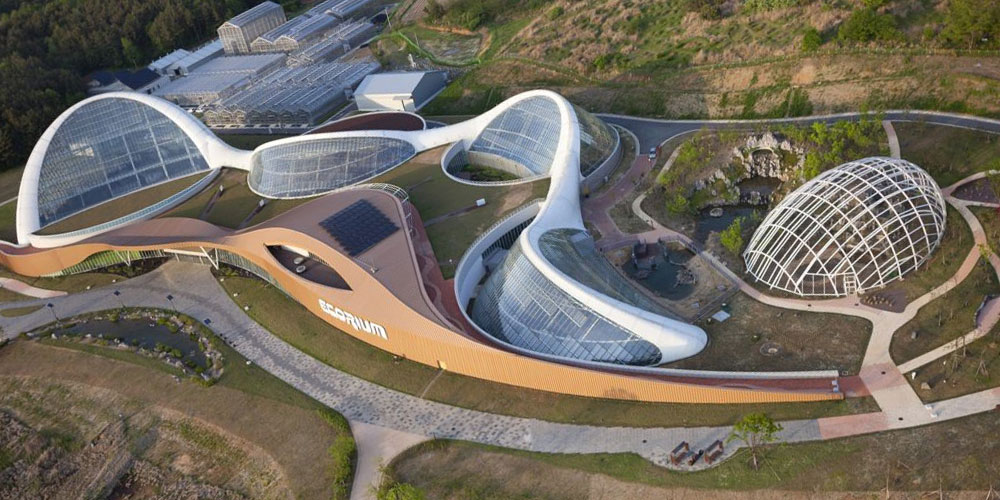
Stage two - Britain
Britain builds all over the green belt using the ECORR (Eco Construction Over Road and Rail) housing concept. Land that receives sun and rain is classified under a new eco-development guideline as 'premium land' as it can sustain life, acts as a carbon sink, and has to be preserved at all costs. This concept is combined with a movement to fight back against the old architectural paradigm of building residential and commercial property by the side of the road. A rejection of city planning that is not holistic, and instead seeks to create spaces where people want to live. Though many do not know they want ECORR until they see it. However, when they do see it, it leads to a rejection of the soul-destroying concrete jungles of modernist and collectivist 'European' thinking. All roads and rail systems are multilevel and are covered over with habitable space. Living space is moved to the outer layer, the 'skin', which all have roof gardens. Yep, everyone in an ECORR gains a garden built on the roof of the hab below, and their hab-unit is soundproofed. From a satellite photo, all you see is green space of roof gardens, with parks between ECORR blocks. A green and pleasant land once more. A place of tranquillity in a bustling, hyper-paced, modern world.
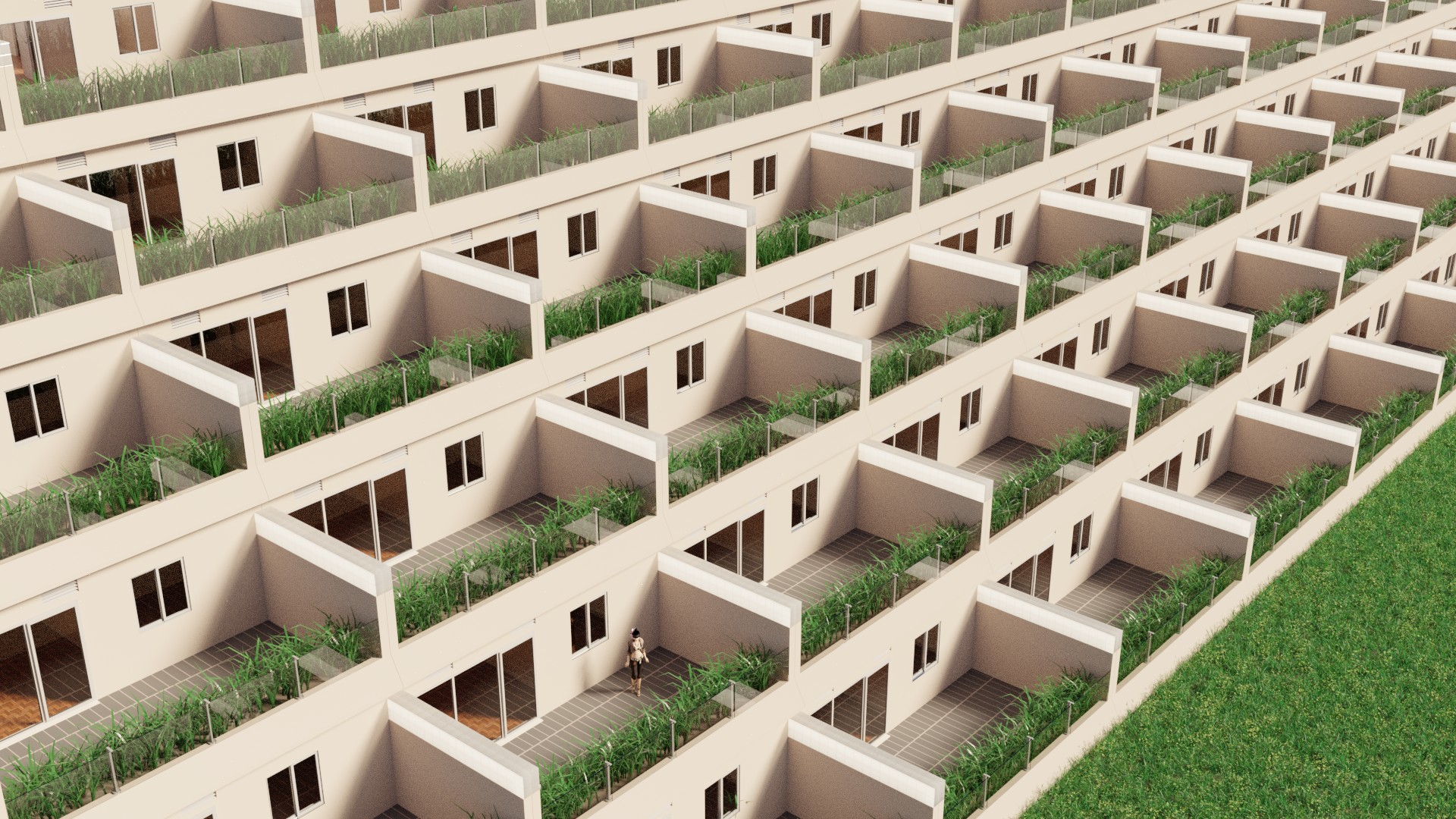
Inside the ECORR is a hive of activity, and contains all the commercial space, co-working spaces, offices, entertainment, gym and other facilities, you'll ever need, all with links to the hidden inner road and transport networks. Co-working spaces and work from home means work comes to you, rather than you travelling to the job. On-site jobs, such as maintenance of an automated factory, is done by remote drone. A worker goes to a co-working space and 'remotes in'. As time progresses these drones take over trivial tasks and only require oversight (guess what those drones are going to turn into?)
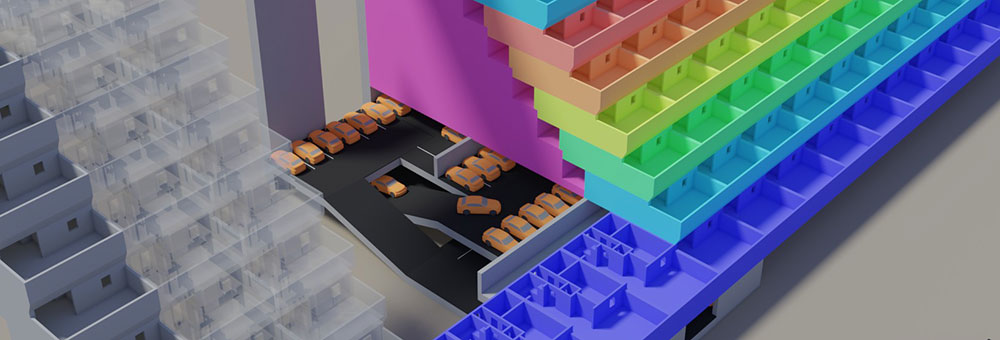
Stage three - The Gulf
Stage one and two are folded into each other. The first true Ecorium are created in the latter half of the 21st century: bio-dome with work and living space combined. (I am not aware of an example as yet on the planet, but it must be coming!). The first examples are built in the Gulf states as they are fantastically expensive. These Ecorium are the brute force terraforming of Earth's desert. Massive drive for self-sufficiency and water capture and recycling. No expense is spared to create a 'green and pleasant land' in the desert. They start out as climate controlled ecotourist attractions at first, but develop into standard housing for the Gulf states.
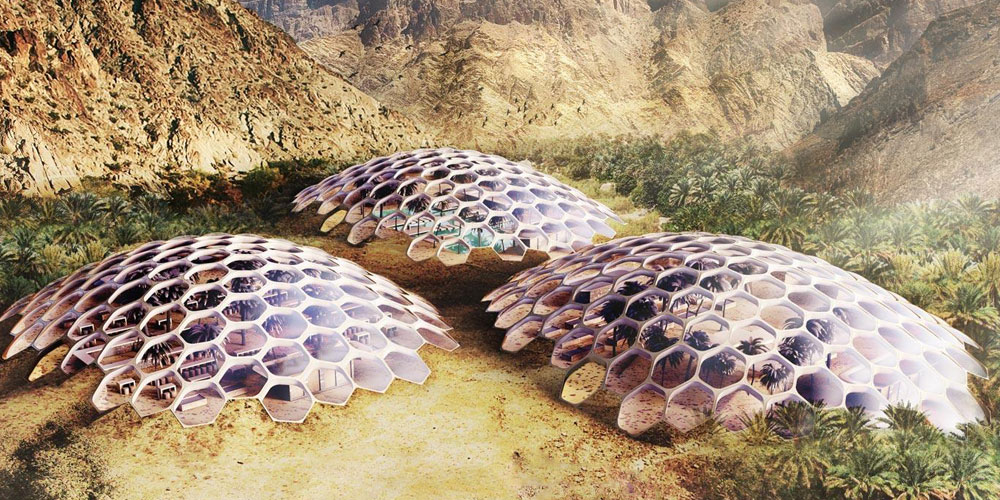
Stage four - Scandinavia
The introduction of artificial light and warehouse farming into the Ecroium equation for countries in the far northern hemisphere, where there is a lack of light during the winter months. These S4 blocks are built in Scandinavian countries and the Arctic. Gardens are not required as they get snowed over, and biodomes are pointless for the same reason. These environmental considerations lead to the utilitarian C-block I designed, and banged on about, back in 2004. (we all know how the Scandos love clean, utilitarian design! It's like the IKEA of environment building). To make it work the clever Scandinavians steal the ravings of a madman found on the Internet Archive and develop the rack-farm system 😛 These rack-farms is structured like a server-farm, except the 'blades' are trays full of plants, or bio-soup, grown under LED and later 'sunlight' emission polymer paints. Sunlight paints are used for all lighting, and linked to a standardised central day/night cycle (with override) which cures SAD (Seasonal Affective Disorder) and vitamin D deficiency.

Usually a glass façade buildings, with the outer windowed areas being hab-units, and the inner core of rack-farms, and IT servers. The inner core generates heat to warm the building.
Stage five - Subterranean
The stage four C-Blocks are built underground to protect from nuclear attack. Subterranean, and miles below the surface, all interconnected with a (British style) tube system constructed within the grid of the K-Block (kilo-block as it is 1km square). Each C-Block is a standardised 300m cube. This military specification becomes the standard for civilian habitats moving past the 22nd century. Where these complexes are built: the surface returns to mother nature.
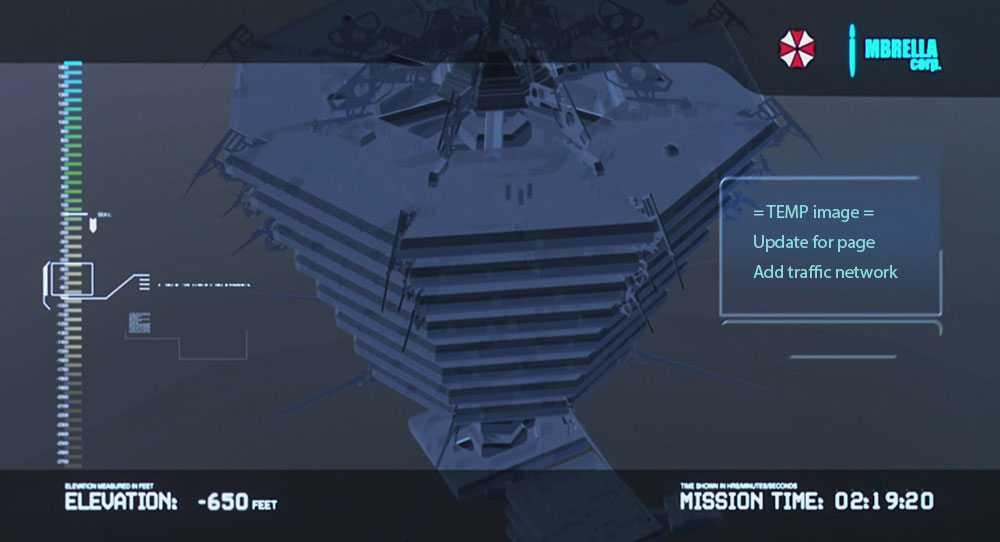
hmm, this probably needs a underground schematic for the final page, like the umbrella corp.
Nuke proof bunkers have long tunnel entrances with right angles to reduce the force of impact on heavy blast doors. However, these blast doors are not 'nuke proof', even the ridiculously thick doors of Cheyenne Mountain complex would not stop a direct hit. This was solved with the 'a tube train on a track' system that completely fills the entrance tunnel. The train is constructed to relatively tight tolerances, with clamp seals, and the carriages are filled with sand to absorb energy. After a nuke strike, the inhabitants do not come out (as the entrances would be known to the enemy, and leaving would mean they are sitting ducks as they exited). Instead, they stay put... for years. Any counter-strike is nuke based, and ground forces are repelled with remote-controlled drones, or illegal sentient killing machines (SKM) developed by the corporations black-ops. When, and if the war is won, the inhabitance can dig their way out, through prepared sand filled tunnels. However, most do not go to the surface unless they have to for work, and then most prefer to run around the surface in a drone.
Stage six - Off World
Seal it up and transport it off world. Brute force terraforming with C-Blocks built by sentient machines (pre-cursor of the Artiloids) on distant worlds. This is where VotNF ends, and Sciror begins.
Subscribe | Patronise | Contact
17 Responses
Hearing feedback is very important to me in developing my ideas. Much of my designs are inspired, and crafted, by chatting to fans on forums before snowballing into a full concept you'll find here. I would like to thank all those who have contributed critiques and participated in discussions over the years, and I would especially like to thank all those who commented on this specific topic. If you would like join in, you are most welcome!
To support my work: Connect

I'm really digging this setup so far. I'm very curious to see how you will be dealing with off world versions. Gravity (more likely artificial gravity) becomes a major challenge here I think.
Another development I don't see mentioned here is (human made) climate change. Maybe I'm opening a big can of worms here, but considering the potential consequences we're dealing with here, I could see this as being more reason for the Ecorium development, and would most likely have a great impact on how it will develop.
It depends on which type of off-world scenario we are talking about: Ecorium will be build on worlds with 1G, it's one of the parameters for settlement. A space station will spin, and centrifugal force provide the 'gravity'. Lastly, a spaceship will use the grav-plates, which is based on phased material (matter attractors).
Competing fiction
Climate change is a prediction about the future, and therefore is technically a 'fiction'. It is also a fiction that is disputed by conservative types. I'm a 'Classic British Liberal', and in designing the Sciror framework I want to include everyone, and that includes conservatives. After all, they are half the population, and I think they would like some games to play as much as anyone else. By stripping out climate change, and making it another 'fiction block' for a scenario, a conservative can choose if they want 'climate change' as part of their Sciror constructed background. It also means that the development of the Ecorium is not reliant of climate change, and therefore the concept cannot be dismissed out of hand by conservatives due to it relying on something they fundamentally disagree with. Remember that the Ecorium is designed taking into account all political groups, all lobbyists, pressure groups, and is universal.
Part of the horror of Sciror is that I am not going to make it easy for the viewer to dismiss the concept out of hand because I will take the viewer's sensibilities into account. I'm here to provide solutions at the VotNF level that attracts all. The selling point of Ecorium is that it is a better place to live: for everyone.
Notes on conservatives: What is unusual about the Anglosphere is that Conservative = Individualist, but on the continent (Europe) and the rest of the world Conservative = Collectivist. This mismatch causes a lot of confusion. Anglosphere Conservative types tend towards nationalism based on liberty, values, and universal rules and reject race as a consideration. Non-anglosphere Conservatives tend towards nationalism based on parental authority, race/ ethnicity, and variable rules. On the other side of the political spectrum: it seems the Left is Collectivist, but the mild left (original liberal, CBL, me) is Individualist? I suspect the political compass may be incorrect. I consider 'Collectivist - Individualist' more accurate, though the Nazis and Communists end up on the same side: and both sides hate that! And yes, all types are taken into account in the design of the Ecorium. No one escapes.
You see, the way I figure it; In creating a fictional faction, it has to appeal to those who will ally with that faction naturally, else it falls flat. This consideration of natural proclivity also means that the factions will be more believable and three dimensional to their followers, while also being recognised as a 'real' threat to the other side. I'm not interested in 'pantomime' villains. I will write factions from 'their point of view'. I want viewers to agree with their faction, and for all sides to think they are correct.
Regarding the climate change discussion, I guess this is where the idea of Sciror as a framework/sandbox comes in. Those who use the elements to create their own narrative creations can include whatever elements they want in it. Sort of like how both conservative and liberal artists/writers can for example work on their own Batman projects, both are still Batman, but each will have a different spin on the characters and setting. We see the same when it comes to the whole vampire mythos in which some approach it in an almost romantic way when looking at nobility and such whilst Andy Warhole's Blood for Dracula could almost be seen as a Marxist spin on the mythos.
Regarding life in the Ecorium and your own notions on individualism you might want to look into 'statist individualism'. You can read a bit more about it here: https://en.wikipedia.org/wiki/Statist_individualism It's basically a Swedish societal model arguing for an alliance between the individual and the state. We could see a more extreme form of it being implemented in the fourth stage Ecorium.
Yep, the modular structure allows you to create the world you want by using a whole selection of background blocks as a foundation for your setting. At the same time, the core blocks are designed to be 'universal'. For example, an environmental activist may like the idea of the Ecorium due to its water recycling, heat reclamation, and solar technologies, while a conservative may like the gated community aspect with all the services on offer, while both like the community building aspect. However, the creator could throw in extreme climate change, and then desert or ice Ecroium systems come to the fore. Or they could go with collectivism run amok and the collapse of the modern world. It is up to the creator the scenarios they present to their players or if not a game: their audience. Sciror is the springboard to get it all going.
As for Individualism, and as you may have guessed, I have my own take that I'll be exploring. I want to present the 'British Archetype' which I see as the true form Individualism, which I observe among my fellow British citizens, mainly in the working class. However, there seems to be no books on it, though Locke and Smith touched upon it, and things have moved on since then. The British tend to shy away from philosophy, seeing it as a German or French thing of telling people what to do. We seem to think of it as a waste of time: basically waffle and nonsense, and that you should just get on with it. We muddle through. When the British do philosophy, it tends to meander all over the place and lacks focus because of all the caveats and exceptions. However, if something is not articulated: then ideas that are articulated will win out in media, and academia, as it is very hard to talk about something that has not even been formulated. None of the middle class seems to think the working class have anything to offer when it comes to moral thoughts and actions in the world despite the fact we have been fighting for our version of Individualism for over a thousand years. I think the working class have a wealth of 'embodied' action, they know what's right when they see it, and I want to articulate that. I think designing philosophy is no different to designing a game background, and society has done all the heavy lifting, so I merely have to describe what I see and not design anything other than how to present the information. That doesn't sound too hard, so I'll give it a shot.
Having said all that: 'Statist Individualism' is, using my ideas, pure collectivism. The reason being that it makes the group more important than the individual, which is the basis of collectivism. It infantilises adults, but putting a parental state over them. It will do what all collectivism does: uniformity of the population, equality of outcome, stagnation, break down of bonds, alienation and isolation with the only joy left being worship of the state and those in charge. As I say, if the British Archetype is not articulated other ideas win out, and as a result terms like 'State Individualism' do not sound like an oxymoron. However, it will make a good base for a scenario and faction.
All this structure affects the designs. In having a clear idea, in game terms, of philosophy: it makes it easier to design factions. For in-game immersion, the 'British Archetype' will be the creation of the Artliects (does that make me an Artiloid?). It will be the logical machine breakdown of the human rule set: philosophy, morality, ethics, economics, and politics. All that ties into the Mars Accords and Article 5.
Not sure if I'd fully agree with your analysis of the Scandinavian model here. What we see in those countries is a level of individualism and independence that is amongst the highest in the world. It not only emancipates them from the collective (family, community), but the state facilitates them to become independent financially. What we see here isn't the state as some sort of parental figure, but more akin of an effective manager whose function is to enable its citizens to live their own lives.
I think this might partly intrigue you: The Nordic Way (read the second article)
I think we have a different understanding of 'Individualism' for example England has had Trial by Jury since around the 12th century. Whereas it's kinda new in the Nordic countries, and their implementation is terrible. Generally we, the British, do not trust government to make judgements. We even have 'jury nullification' so we can reject laws we do not like, and the judge can do nothing about it. Common people decide. It seems many Europeans think that taking any old person off the street to render judgement is lunacy. Whereas we think 'they're British, they'll do'.
I had a quick skim through the linked document, and it seems to be treading on the same path as 'atomised individualism' which comes under collectivist control, as the state is pulling the strings (it's inherent in stage 4 Ecorium above). Skipping through the text it's alarming how incredibly controlling it all is, but that might just be culture clash. However, I'll have a proper read when I have time, as there is always nuance and I'd like to talk about it using the most recent version.
Both concepts of Individualism, British and Nordic, are very different, but both have the same name. It would be fun to lay it all out, as I say, most outside Britain have no idea how our systems work, or could work, and find some parts of our culture like 'banter' baffling.
Each Ecroium has to take into account the culture it will be developed in. That is why stage 4 looks the way it does - it seems appropriate, it seems 'Scandinavian', utilitarian, uniform, functional, though I may have overdone it 😛
I think this is very much where our 'cultural' differences come in. But you do raise a point regarding collectivist control. But this all kinda has to do with how we view freedom. Americans (and maybe also Brits) tend to view the state as opposite to freedom whilst continental Europeans view the state as a means of providing freedom through social welfare systems (freedom from poverty etc). The Scandinavians take this even one step further and see the state as a means of liberating themselves from family/community.
Another article on the same topic (but with a few more critical notes): http://www.larstragardh.se/wp-content/uploads/2010-Pippi-Longstocking-in-Swedish-Modernism.pdf
This is kinda where the sandbox of Sciror becomes interesting. We would almost have an academic/philosophical debate, but instead of it being being done through academic publications, it would be through background, models, artwork, etc.
The type 4 Ecorium, at least the early version of the type 4 (which I guess is originally Scandinavian) would probably also come with a very Scandinavian societal model.
I think the issue in the culture class is that continental Europe did not want the modern world brought about by Britain (with some of the groundwork laid out by early Islam). They like the wealth created, but want to retain their old ways, and seem not to trust the common people.
It reminds me of eBay as a startup, where those who 'knew better' thought it a joke and would fail as everyone would send empty cardboard boxes and all payment cheques would bounce. Yet it worked just fine. That is where the disconnect is.
Europeans seem to dislike capitalism where people decide the market, they do not like juries of common people making judgements, and looking at the EU it seems they do not like people voting and would rather hand decision making over to technocrats.
Feudal
Continental Europe still has (seems to me) a 'feudal' mindset, as if they are all still peasant farmers taking instruction from the lords and masters (who 'know better'). It's no different from a monarchy, where everyone is an atomised individual subject of the crown, and none have rights without the crown (which could be taken as ironic considering our setup, but we negotiated our monarch into giving us our sovereignty). Reading that last pdf brought home this fact as even the critique is steeped in this mindset. The mere mention of children as property is horrifying, as Britain's were at the forefront ridding the world of slavery. We are very aware that a chattel slave is an atomised individual, and that is why reading the PDFs you linked to is so jarring. I know that is not what they mean, but it is how it sounds as all the premises are based on a world view we rejected a long time ago.
Collectivist right
To my mind, the collectivism the Nordic states are claiming in the article is actually the collectivist right of parents, and that is the only place where collectivism is acceptable. All the arguments they make for the state to have those rights is the same argument that parents have that right. After all, what gives a politician more right to bring up your children if you are both sovereign adults? The difference is that the parents love their children, while a politician can never claim they love someone else's children more than the parents themselves. The utter power of collectivism is ameliorated by that parent's love for their children. Without that love: it is a disaster. And while good people may behave with that power, bad people run amok. British individualists have the right of self-defence and the defence of others, if the parents are doing something evil, you can step in. Otherwise, it is none of our business and definitely nothing to do with the state. Once a child grows up, at 16, they are 'liberated' (a callous way of looking at it) from their parents, they leave collectivist control and become true Individualists. Individualism only relates to adults, not children. The state laying claim to children is usurping the power of the parents simply because the state has more guns, a bigger mob, and 'might is right'. It does not sound all fluffy and modern to me. However, it did make me smile when they patted themselves on the back for being all modern and ahead of the game.
Islam
The search for truth, for example: predicting when the sun would rise for morning prayer, which was not in the Quran (a bit of an oversight - but the praying 5 times a day was taken from a Christian sect later), led Islam to Individualism, evolving naturally in the search for the truth. Groups cannot think as one mind, only individuals can think, but groups share what individuals create. This means that to solve problems an individual has to think for themselves and the solution may challenge dogma. The emergent individualism led to the further development of maths (example: algebra) science (examples: astronomy, optics), and the beginnings of the scientific method laid out by Ibn al-Haytham, a stunning mind. Unfortunately, it was crushed by collectivism which rejected philosophy, logic, mathematics and physics. They have been stuck ever since. Absolutely tragic, can you imagine how they could have developed if they were not artificially shut down?
Real Revolution
Britain had been pushing Individualism for over a thousand years, due to our rebellious nature, and when we were exposed to science from Islam, we took to it like a duck to water. That's not to say other European countries did not take to science; they did, the difference was the Individualism in the British driving it forward.
In the last 200 years, we went from £1 a day as a peasant farmer, where it should be noted that £1 is in today's money (same spending power - there is a reason people used to make their own bread!) to the modern world. The stages of development;
£1 > Individualism (free speech) > The Science Revolution > Second Agricutal Revolution (£1.70!) > Capitalist Revolution > Industrial Revolution > Services Revolution (today £78).
That's a lot of revolutions!
Now 80% of GDP of modern countries are services. Even benefits in Britain are over 20 times what a person used to earn before capitalism. The entire Anglosphere has the same values as the British, and that includes American, Canada, Australia, etc. and the same values are in India, Nigeria etc. Capitalism has lifted billions out of poverty; in 2010 we (all of us) beat UN targets to halve poverty by 2015 by five years. All this is possible because of capitalism, moving from a zero-sum game of land grabs and agriculture to the positive-sum game of generating wealth through innovation and ideas, and everything built thereafter on that foundation.
Yet Europe seems to want to turn corporations into pseudo-government bodies that act like fiefdoms writing their own laws, in the US corporations are used to get around free speech. It seems trendy to hate capitalism while not understanding how it works, or the benefits it has brought, or worse still: the failure of all alternatives. The whole world seems intent on destroying the very foundations upon which the modern world is built upon and think it will turn out fine?
The end is nigh 😛
The same collectivism that crushed the golden age of Islam is more than powerful enough to crush the modern world. Collectivism always destroys, it always leads to war, it's always a zero-sum game of taking from others. That's how it works, because it is really for a family, taking the wage earned by the parents and distributing it among the family where all benefit. It does not scale.
Critique and corrections welcome 🙂
I've said it before, but many of your architectural ideas remind me of the "First Millennial Foundations" concepts for eight "easy" steps to colonise the galaxy. Off the top of my head, "Aquarius" is one of the more obvious developments that should fit into the Ecorium premise:
https://en.wikipedia.org/wiki/The_Millennial_Project
It's getting increasingly harder to find the digital concept art that they produced. Maybe I should just order the book again and do some scans.
From memory, the different stages were:
Aquarius. This was the coolest to me. Basically, they shipped in a large 300 MW Ocean Thermal Energy Converter (OTEC) and connected it to a manganese (?) skeleton and electrolytically deposited "sea-crete" onto it. The OTEC was a hexagonal "cylinder" and, around it, the skeleton formed rings of hexagon "cylinders." The OTEC was the highest, then each ring smaller. On top of each hexagon was a garden space, and the rings extended down to sea level. Mariculture was prominent, and around each Aquarius was a wave dampener for harsh weather conditions. The main economy of Aquarius was data, and "everyone" were telecommuters. http://www.luf.org/aquarius.php
Bifrost. This was a huge mass driver built into the side of Kilimanjaro that accelerated pods with huge ice cubes in the back. The pod accelerated gradually and, when ejected out of the end of the tube (at the top of the mountain, lasers fired at the ice which gave it the final "boost" to reach escape velocity. http://www.luf.org/bifrost.php
The basic premise of Aquarius then translates over to the other phases, in a similar phase that you see the Ecorium design extending to other environments. Asgard, for example, was a spherical construct with sub-spheres (let's call them 'subsectors' 😉 ), and then component spheres under that to provide individual habitats.
Avalon then used the same kind of water-filled domes on the Moon, Elysium started out similarly for Mars, and so on.
Just a quick thought.
Thanks for the links. I think we can incorporate some this as a precursor to stage 6, or replace stage 6, as sixes can be built anywhere. It would be appropriate to test them underwater on Earth before building them on the Moon or Mars. All powered by an OTEC. Perhaps add in some windows! Though if really deep in the ocean there my not be much to see 😛
It seems a logical step that air locks for dealing with entry into an under water Ecorium can be the basis for universal air-locks on Ecorium built on other worlds.
Also, the Mass Launcher may be an idea for pre-gravity lift technology, to get all the construction material needed into space to make a space station. I imagine the space station will be a bit 2001 (or like those onion flavour corn snacks I ate when a kid) except the ring is all Ecorium and powered by nuclear energy (maybe a Thorium reactor for efficiency).
Not as high-brow as some of the other posts, here, but just trying to be a useful appendage rather than flopping around. Certainly, the design aesthetic is similar to your Stage 1. I've always been attracted to the more organic lines, finding them more relaxing on the mind than stark geometry (even though I like the symmetry). I guess that's mostly why I liked the Eldar / elven aesthetic more than the human (or other races) from various fantasy, sci-fantasy games backgrounds.
Glad that you could find something from it.
Much appreciated. I'm writing up the draft of stage 6+ and I've included underwater Ecroium! 🙂
As the for aesthetic: When I get back to messing with the ECORR system I'll tart it up a bit. As we'll be building on green belt land I'm thinking of adding in organic swooping lines, though it will retain the tiered structure (kinda like the Longji terraced rice fields in Guangxi). Swap the grass banks for full height windows, and the top waterlogged fields from grass and gardens and you get the idea. So not full Eldar 😉
Regarding the aesthetics, I would imagine these wouldn't be fully standardized. Meaning you'd have a very diverse array of styles of shapes for the ECORR / Ecorium systems, from organic (maybe even grown) shapes to very straight brutalist blocks. The same could be said for how humans would interact with their structures. We are currently moving into territory in which we can directly interact with our homes (think of stuff like SIRI, ALEXA, Google Assistant, etc). At a later point we could also see more organic/symbiotic designs in which the house kinda becomes an organism of its own, that could aesthetically be either very Cronenberg bio-horror like, or very clean and IKEA like, the possibilities are endless here.
I agree. I imagined the ECORR concept more as a new paradigm in architecture than a specific design. The common design elements that mark out ECORR are: all upper surfaces are green, and all buildings cover the road and rail system. Along with a lot of recycling facilities. From a satellite view, no matter the design, all your see is green space, gardens, parks, wildlife preserves etc. and no roads or rail systems (that is all hidden). All the designs do it create different shaped boundaries. This makes it very easy to spot ECORR. Technically even the subterranean c-blocks fit this definition as all rail systems are underground and the surface is all forest, meadows, and prairies etc. However, the underwater version of stage 6 (redone after input from Kage) does not match the 'upper surfaces are green' definition, through it is covered in mother nature, and the orbital stage 7 really does not fit.
Forgive the laziness, but I'm going to go with pseudo-quoting because my brain is fuzzy after too much audio and video editing. Gah.
Agreed. For lack of a more scholarly example, just look at the evolution--backward and forward, as it were--between car aesthetics. They frequently shift from organic to harder lines and back again. Older designers are reimagined with newer lines etc.
Which is a way of saying don't let me fetish for organic lines and sweeping shapes to get in the way of your creative feng shui. With that said, factoring it in might make it more broadly applicable. In some ways, encountering for the variation would even support the whole STC integration for that angle of your imagination, while also getting into some of the ideas that had it as more adaptive. (Rather than stick a square block and call it a house in an environment with extreme winds, if the tech is available you make the extreme windows work for you...)
In some "cyberpunk" RPGs you would buy certain levels of lifestyle, which might include adaptable housing systems. For some reason I'm channeling CyberGeneration where they called it "Virtuality," but basically it's just enhanced augmented reality that you used to "skin" your apartment. You could have some fun with this idea in reference to ECORR and what might otherwise by habitat tetris--the physical spaces are blocky, but the perceived spaces are anything but. Couple that with small living space customisation and...
Well, just a thought. You just might have some fun social implications resulting from it.
Also, FWIW, this kind of "skinning" was what I was going with for "data temples" of the Adeptus Mechanicus. You basically had a full AR environment but, once you moved out of it, you were limited in what you could do (hence shifting to haptic and IR control systems--lots of gesticulating and "moaning and chanting," though).
Just something to consider, is that humans generally like space and variation. So there are times that you might want your transit systems to extend outside of the underbelly ("Oooh, aaaah--pretty!") or consider another "skinning" situation where you take the green and the expansive views to them in another way.
Again, just a thought.
Are you talking the--what was it called?--Asgard premise?
Stage 7 does not fit in with the idea of 'upper surfaces green' as it is a rotating space station, and there are no growing surfaces facing the sun. It uses rack-farms: so everything is hidden away. Later, we could include some non rack-farm bio-domes, but due to using 'centrifugal force' as artificial gravity, and the outermost wall being solid to support all that soil, it may be awkward as all the domes will face inward, not outward.
For variation of ECORR it will follow British roads! I imagine that will provide all kinds are variation 😛 However, our American cousins seem to like uniform grid systems for their cities (and we with Milton Keynes), so some humans may prefer uniformity than variation. Looking at New York, it is all very similar. ECORR would be the same except more green roofs, hidden roads, and more central parks. I imagine those implementing ECORR designs will adapt it to the environment it is being applied to.
The 'Ecorium Development' posts have been combined and added to a page under Visions of the Near Future.